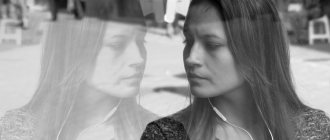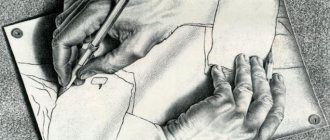Representation: Properties and Functions
Performance
- the process of mentally recreating images of objects and phenomena that currently do not affect the human senses. The term "representation" has two meanings. One of them denotes the image of an object or phenomenon that was previously perceived by analyzers, but at the moment does not affect the senses (“name of the result of the process”, deverbative). The second meaning of this term describes the process of image reproduction itself (“name of the process”, substantivized infinitive).
Presentation functions:
Representation as a cognitive process has the following functions.
1. Signal function
consists in the development of signals related to those properties of the represented image, which can subsequently be used by a person in his activity.
2. Regulatory function
is associated with the selection of those properties of the represented object that are necessary at the moment to perform any actions.
3. Setting function
involves the formation of a program of action specified by the parameters of the current or upcoming situation.
Properties
Representations have such basic properties as clarity, fragmentation, instability and generality.
1. Visibility.
A person represents the image of a perceived object exclusively in visual form.
2. Fragmentation.
The presentation of objects and phenomena is characterized by uneven reproduction of their individual parts. Advantage is given to objects (or their fragments) that in previous perceptual experience had greater attractiveness or significance.
3.Instability.
The image (or its fragment) presented at a given moment in time can be held in active consciousness only for a certain time, after which it will begin to disappear, losing fragment after fragment. On the other hand, the image of representation does not arise immediately, but as new aspects and properties of the object, new temporary connections are perceived; gradually it is supplemented, changed and “clarified”.
4.Generality.
The presented object, its image, has a certain information capacity, and the content (structure) of the image of representations is schematized or collapsed. As BC Kuzin points out, representation always includes an element of generalization. In it, the material of an individual perception is necessarily associated with the material of previous experience and previous perceptions.
The concept of sensory threshold and methods for its determination.
SENSORY THRESHOLDS
1. Absolute sensitivity of the touch system
2. Differential sensitivity of the sensor system
3. Spatial difference
1.
The absolute threshold is a type of sensory threshold described by G. Fechner. Characterizes the sensitivity of the sensory system. It is expressed by the magnitude of the stimulus, the excess of which gives a response from the body, primarily in the form of awareness of the sensation. The sensitivity of the system and the reaction threshold are inverse concepts: the higher the threshold, the lower the sensitivity, and vice versa.
Lower intensity values are considered subthreshold, and higher ones are considered suprathreshold.
In the subthreshold range, a reaction to ultra-weak stimuli is possible, but unconscious - it does not reach the threshold of sensation. Such sub-threshold or subsensory reactions were first described by G.V. Ger shuni, who discovered them in people shell-shocked in the war. If the intensity of the light is reduced so much that a person can no longer tell whether he saw the flash or not, then an imperceptible galvanic skin response to a given signal can be recorded from his hand. The operation of a “lie detector” is based on this procedure.
Sensory threshold is a conventional concept, that is, it depends on its exact definition, or agreement (convention) between people. It must always be precisely determined by which reaction the threshold is measured, what magnitude of this reaction or the probability of its occurrence will be considered threshold. This means that the threshold criteria must be clearly defined.
Signal detection is significantly influenced by the process of spatial and temporal summation. They come down to the ability of the sensory system to accumulate signal energy distributed over a certain zone in receptor space or in time.
Increasing the size of the sensory stimulus and its duration to a certain limit reduces the threshold. This limit is called the critical size, or the critical duration of the stimulus.
2. Differential touch sensitivity
based on the ability of the sensory system to distinguish signals. An important characteristic of each sensory system is the ability to notice differences in the properties of simultaneously or sequentially acting stimuli.
Discrimination begins in the receptors, but neurons from all parts of the sensory system are involved. It characterizes the minimum difference between stimuli that a person can notice (differential or difference threshold).
The threshold for distinguishing stimulus intensity is almost always higher
previously existing irritation to a certain extent (Weber's law). This dependence is expressed by the following formula:
dI/I = const, where:
I - strength of irritation;
dI is its barely perceptible increase (discrimination threshold);
const - constant value (constant).
The dependence of the strength of sensation on the strength of irritation (Weber-Fechner law) is expressed by the following formula:
E = a logI + b, where:
E - magnitude of sensation;
I - strength of irritation;
a and b are constants that are different for different stimulus modalities.
Modern psychophysiology also uses methods of sensory scaling to assess the strength of sensation, that is, a person’s subjective assessment of the strength of his sensation by comparing it with a previously created standard or set of such standards. The relationship between sensation and stimulus in this case is expressed by a power function (Stevens' law).
A comparison of the logarithmic function of the Weber-Fechner law and the power function of the Stevens law showed that in the main, working part of the intensity range, these functions give quantitatively similar estimates.
3.Spatial discrimination
signals is based on the nature of the distribution of excitation in the receptor layer and in the neural layers of the sensory system. So, if two stimuli excite two neighboring receptors, then their differentiation is impossible: they will merge and be perceived as a single whole. It is necessary that between two excited receptors there is at least one non-excited one.
Temporary discrimination between two irritations is possible if the neural processes caused by them do not merge in time, and the signal caused by the second stimulus does not fall within the refractory period from the previous Irritation. The neurophysiological basis of temporal resolution is the so-called excitability cycles, or response recovery cycles. They are judged by the magnitude of the response to the second of two sequentially presented stimuli.
The so-called “sensory masking” is based on the temporary interaction between successive stimuli. It underlies many sensory effects and is widely used in psychophysiological experiments. The masking itself is directly related to the entry of one of the stimuli into the refractory phase of the excitability cycle after the first stimulation.
A distinction is made between direct masking, in which the response to the second stimulus is inhibited, and reverse masking, in which the second stimulus seems to interrupt or interfere with the processing of information about the first signal.
According to the degree of volitional effort
By degree of generality
By analyzer
Types of performances.
Performance.
Types of illusions.
Affective[13] —
caused by fear, anxious, depressed mood. For example, clothes hanging on a hanger may seem like a robber, and a random passer-by may seem like a rapist and murderer.
Movements. For example, when a person sits in a train carriage, looks out the window and waits for the train to start moving, and another train begins to move past, and this movement creates the illusion of the movement of a stationary train in which the person is located.
Verbal —
false perception of the content of actually occurring conversations of others. For example, it seems to a person that these conversations contain hints of some unseemly actions, bullying, hidden threats against him.
Pereidolic (around-shaped) illusions - associated with the activity of the imagination when fixing the gaze on objects with an unclear configuration, caused by a decrease in the tone of mental activity. For example, ordinary patterns on wallpaper are perceived as fantastic monsters and extraordinary plants.
Hallucinations are disturbances of perception that arose without the presence of a real object. A person in the grip of hallucinations experiences them as truly perceived, ᴛ.ᴇ. people really see, hear, smell, and do not imagine or imagine; with them, sensory sensations are just as real as those emanating from the objective world.
Representation is a mental process of reflecting objects and phenomena that are not currently perceived, but are recreated on the basis of previous experience. The physiological basis of ideas is made up of “traces” in the cerebral cortex, ᴛ.ᴇ. “first signals” extracted from memory.
1.1 Visual
1.2. Auditory
1.3. Olfactory
1.3. Tactile
2.1. Single - based on the observation of one subject.
2.2. General – generally reflecting the properties of a number of similar objects.
3.1. Involuntary - ideas that arise spontaneously, without activation of the will and memory of a person.
3.2. Voluntary - arising in a person as a result of volitional effort, in the interests of a set goal.
According to cognitive processes
- memories - arise on the basis of direct perception in the past of an object or phenomenon.
- imaginations - are formed on the basis of information received in past perceptions and its creative processing.
— perception
— thinking
— speeches
2.3.2.1. Fragmentation
– the presented image often lacks any of its features, sides, or parts. For example, when we imagine someone’s face, we clearly and distinctly reproduce only individual features; other details only appear slightly against the background of a vague image.
2.3.2.2. Instability
(or
impermanence)
- the representation of any image sooner or later disappears from the field of human consciousness.
2.3.2.3. Variability
– when a person enriches himself with new experience and knowledge, a change in ideas about the objects of the surrounding world occurs.
2.3.2.4. Panoramic
– going beyond the perceptual field.
Basic properties of perception.
⇐ PreviousPage 6 of 14Next ⇒Perception is the process of processing sensory information, the result of which is a reflection of the world around us as a collection of objects and events. Perception, in contrast to sensation, reflects the object as a whole, in the totality of its properties, and not individual properties. Perception, a qualitatively new stage of sensory cognition with its inherent characteristics, like any other mental phenomenon, can be considered both a process and a result.
The main properties of perception include: objectivity, integrity, structure, constancy, meaningfulness, apperception, activity.
Objectivity of perception
The objectivity of perception is its ability to reflect objects and phenomena of the real world not in the form of a set of isolated sensations, but in the form of individual objects. On the one hand, the inclinations of objective perception are laid down by nature, and there is no doubt that in animals perception is also objective. On the other hand, we can say that objectivity is not an innate property of perception. The fact is that the emergence and improvement of this property occurs in the process of ontogenesis, starting from the first year of a child’s life. I.M. Sechenov believed that objectivity is formed on the basis of movements that ensure the child’s contact with the object. Without the participation of movement and activity in general, images of perception would not have the quality of objectivity, that is, being related to objects of the external world. The question of the relationship between biological mechanisms and experience in perception remains not fully resolved. In ensuring the objectivity of perception, motor components of activity are of great importance:
- movement of the hand, in particular the fingers, feeling the object,
- eye movements tracing the visible contour of an object and also, as it were, “feeling” this object remotely,
- turning the head (for example, towards a sound source),
- other movements.
Integrity of perception
From individual sensations, perception synthesizes a holistic image of an object; this property of perception is called integrity. A holistic image is formed on the basis of a generalization of information received in the form of various sensations about the individual properties and qualities of an object. We do not perceive separately: a person’s eyes, ears, mouth, nose, as well as a person’s voice and his smell. For us, all this is united into one holistic image of a person. In this case, the image even turns out to be multi-layered: we perceive not a head placed on top of a shirt or dress, but a shirt or dress put on a human body, although we do not see this body itself. The experience of previous observations is of great importance for holistic perception. Seeing a person standing sideways to us, in our perception we have a complete object: having two arms, not one, having two legs, not one, having two ears. And when a person turns his other side to us, we see what we were already prepared for. The perception of a particular person is therefore strongly connected with his model of the world and the model of individual objects in this world. If, suppose, a child’s father is very tall and wears glasses, then the child’s model of the world may reflect the connection “tall height = presence of glasses.” Then meeting strangers wearing glasses on the street, the child will consider them somewhat taller than they actually are (especially if there are no other people nearby with whom the stranger’s height can be compared).
Structurality of perception
The structure of perceived images facilitates the work of our consciousness. It does not work directly with “megabytes” of visual and auditory information. These “megabytes” are not projected directly into consciousness; we actually perceive a generalized structure (or model) abstracted from these sensations, which is formed over some time. If a person listens to some musical opus, then he is not aware of every sound he hears, especially since he is not able to analyze that giant sinusoid reflecting air vibrations. Only a generalized scheme is reflected in the human mind, which reflects the characteristic features of the opus. This pattern is called a melody. Understanding the melody does not come immediately, from the first notes; sometimes it takes several listens to understand it. Unlike musical opuses, which do not vary much in complexity, visual objects can range from very simple to very complex. It could be “The Last Supper” by Leonardo da Vinci, or a drawing of a house made by a child. Accordingly, it may take either a fraction of a second or many days for the image-structure to reach perfection.
Constancy of perception
Constancy of perception is the relative constancy of certain properties of objects when the conditions of their perception change. For example, a truck moving in the distance will still be perceived by us as a large object, despite the fact that its image on the retina will be much smaller than its image when we stand near it. We can perceive the same objects in different conditions, for example, under different lighting conditions or from different viewing angles. The task of perception here is to smooth out these differences and present to consciousness not a fundamentally new object, but the same one, only surrounded by slightly changed circumstances. If perception did not have the property of constancy, then a person who turned his other side to us would be perceived by us as a new person, and, moving away from his home, we would not recognize him. The most noticeable constancy of perception is observed in the visual perception of color, size and shape of objects. Constancy of color perception consists in the relative constancy of visible color when lighting changes. For example, a lump of coal on a sunny summer afternoon will be about eight to nine times lighter than chalk at dusk. However, we perceive its color as black, not white. At the same time, the color of chalk will be white for us even at dusk. The phenomenon of constancy in the perception of color is determined by the combined effect of a number of reasons, including adaptation to the general level of brightness of the visual field by light contrast, as well as ideas about the actual color of objects (based on past experience) and their lighting conditions. The constancy of the perception of the size of objects consists in the relative constancy of the visible size of objects at their different distances from the observer. If a person moves away from us, it does not seem to us that he has become smaller in stature, although his image on the retina has become smaller. The constancy of the perception of magnitude is influenced by both the physiology of the eye and life experience. At distances of up to 10-15 meters, we are able to quite accurately determine the distance to the object being assessed, make a correction for this and determine the objective size. At large distances, we cannot accurately estimate the size of an object, but life experience tells us that the vast majority of objects do not simply change their size.
Apperception
Previous perceptual experience plays a huge role in the process of perception. Features of perception are determined by all previous practical and life experience of a person. Apperception is the dependence of perception on the general content of a person’s mental life. In apperception, by definition, a person’s life experience, including that expressed in knowledge and skills, is of great importance. If we see figures cut out of cardboard, then we automatically look for ready-made templates-categories of perception in our memory: is it a circle, is it a triangle. When perceived through these category templates, past experience is activated. Therefore, the same object can be perceived differently by different people. Through category templates, associations with other previously observed objects or even situations can be evoked. Experience influences not only associations, but also the category templates themselves. Thus, a child’s circle template includes only the circle itself. In an adult and educated person, the circle pattern includes the center of the circle. Experience also improves the accuracy of perception. Through experience, templates are improved and their constant and variable parts are specified. Even if we know a foreign language well, foreign speech still seems unintelligible to us. If we hear our native speech, then even if a person speaks unintelligibly, we perceive it well. The fact is that the sound (phonetic) features of different languages are very different; you need significant listening experience to learn to understand words spoken by a native speaker. Apperception is greatly influenced by a person’s orientation (his interests and inclinations), abilities, character, emotional characteristics, social status, role behavior and much more. The mental state, current attitude, goals and objectives of this activity also influence. A person who is professionally involved in interior decoration easily and quickly notices all the interior features of a new room.
Meaningfulness of perception
Consciously perceiving an object means mentally identifying it, relating it to existing category templates and, perhaps, even naming it, relating it to a certain concept. When we see an unfamiliar object, we try to establish its similarity with other objects. Consequently, perception is not determined simply by a set of stimuli affecting the senses, but is a constant search for the best interpretation of the available data. Interpretation _
available data includes not only the search for truth, but also the search for a way out of a difficult situation, a solution to the problem. Stages of understanding information: 1) identifying a complex of stimuli from the flow of information, 2) making a decision that they relate to the same specific object, 3) searching in memory for the most relevant category templates, similar or similar in composition to the sensations of a complex of signs , by which an object can be identified, 4) attributing the perceived object to a specific category template with the subsequent search for additional signs that confirm or refute the correctness of the decision made (development of a temporary hypothesis), 5) forming a final conclusion about the correlation with a specific category template, 6) addition of the template with individual characteristics of the perceived object (“person-woman”, then individual characteristics: “young”, “beautiful”).
Perceptual activity
We can control our perception within certain limits. Putting on headphones, we forget about the book and plunge into the sweet world of music. Taking off our headphones, we go to the kitchen and eat a freshly baked fish pie. If we feel uncomfortable leaning over the pie, we can take the dish with it in our hands and bring it to our face. Therefore, at a minimum, we can control our perception through: manipulation of our own senses, attention, our own movements in space, movements of the perceived object. One of the basic features of our perception is the division of all perceived information into “figure” and “ground”. The figure usually contains one object or a group of closely related objects (for example, two boys fighting). Everything else is in the background. The main manifestation of the activity of perception is to determine what at a given moment should be a figure and what should be a background.
Question 11.
⇐ Previous6Next ⇒
General characteristics of perception
Perception is the reflection in the human mind of objects and phenomena in the totality of their properties and parts with their direct impact on the senses.
In the course of perception, individual sensations are ordered and combined into holistic images of things and events. Unlike sensations, which reflect individual properties of the stimulus, perception reflects the object as a whole, in the totality of its properties. Perception is associated with awareness, understanding, comprehension of objects and phenomena, with their attribution to a certain category based on appropriate characteristics and grounds. Only by including an object or phenomenon in a certain system, embracing it with the appropriate concept, can we correctly interpret it.
Thus, perception acts as a meaningful (including decision-making), meaningful (associated with speech) synthesis of various sensations obtained from integral objects or complex phenomena perceived as a whole. Since perception is a sensory stage of cognition, it is associated with thinking, has a motivational orientation, and is accompanied by an emotional response. It is on the basis of perception that the activity of memory, thinking, and imagination is possible.
Human perception is a necessary prerequisite and condition for his life and practical activities. Knowledge of the patterns of perception processes helps to better understand the mechanism of formation of witness testimony, identify the psychological sources of mistakes of the investigator and the court, and on this basis make recommendations for increasing the effectiveness of their law enforcement activities.








